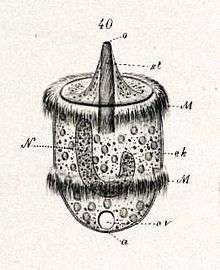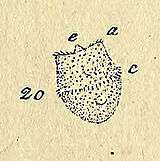Didinium
Didinium is a genus of unicellular ciliates with at least ten accepted species. All are free-living carnivores. Most are found in fresh and brackish water, but three marine species are known. Their diet consists largely of Paramecium, although they will also attack and consume other ciliates.[1] Some species, such as D. gargantua, also feed on non-ciliate protists, including dinoflagellates, cryptomonads, and green algae.[2]
| Didinium | |
|---|---|
 | |
| Didinium nasutum as illustrated by Schewiakoff, 1896 | |
| Scientific classification | |
| Domain: | |
| (unranked): | |
| Phylum: | |
| Class: | |
| Order: | Haptorida |
| Family: | Didiniidae |
| Genus: | Didinium Stein, 1859 |
Appearance and reproduction
Didinia are rounded, oval or barrel-shaped and range in length from 50 to 150 micrometres.[3] The cell body is encircled by two ciliary bands, or pectinelles, an upper band and a lower band just below the midline.[4] This distinguishes them from the related genus Monodinium, which have only a single band, except during cell division.[5] The pectinelles are used to move Didinium through water by rotating the cell around its axis.[6] At the anterior end, a cone-shaped structure protrudes, supported by a palisade of stiff microtubular rods (nematodesmata). This cone encloses the cytostome or "mouth" opening, as in other haptorian ciliates. The dimensions of this protuberance vary among the different species.
The macronucleus is long, and may be curved, horseshoe-shaped or twisted into a shape resembling a figure eight.[7] A contractile vacuole and anal aperture are in the posterior of the cell.[8]
Like all ciliates, Didinia reproduce asexually via binary fission, or sexually through conjugation.
Didinium nasutum

Much of what has been published about this genus is based on numerous studies of a single species, Didinium nasutum. A voracious predator, D. nasutum uses specialized structures called toxicysts to ensnare and paralyze its ciliate prey. Once captured, the prey is engulfed through Didinium's expandible cytostome.[9]
While D. nasutum is sometimes described as feeding exclusively upon Paramecium, it has been shown that the organism will readily devour other ciliate species, including Colpoda, Colpidium campylum, Tetrahymena pyriformis, Coleps hirtus and Lacrymaria olor.[1][10] Moreover, strains of Didinium raised on a Colpidium campylum will actually show a preference for a diet made up of that species, as well as a diminished ability to kill and ingest Paramecia.[1]
In the absence of food, D. nasutum will encyst, lying dormant within a protective coating.[11] In the laboratory, other environmental stimuli, such as the age of the growth medium or the accumulation of certain metabolic waste products, can also trigger encystment.[12] When the encysted form of D. nasutum is exposed to a vigorous culture of Paramecium, it will excyst, reverting to its active, swimming form.[13]
Didinium cysts have been shown to remain viable for at least 10 years.[14]
History and classification

Didinium was discovered by the eighteenth-century naturalist O.F. Müller and described in his Animalcula Infusoria under the name Vorticella nasuta.[15] In 1859, Samuel Friedrich Stein moved the species to the newly created genus Didinium, which he placed within the order Peritricha, alongside other ciliates which have a ciliary fringe at the anterior of the cell such as Vorticella and Cothurnia.[16] Later in the century, under the taxonomical scheme created by Otto Bütschli, Didinium was removed from among the Peritrichs, and placed in the order Holotricha.[17] In 1974, John. O. Corliss created the order Haptorida, within the subclass Haptoria, for "rapacious carnivorous forms" such as Didinium, Dileptus and Spathidium.[18] This group has since been placed in the class Litostomatea Small & Lynn, 1981.
Genetic analysis of Haptorian ciliates has shown that they do not form a monophyletic group.[19][20]
List of Species
Didinium alveolatum Kahl, 1930
Didinium armatum Penard, 1922
Didinium balbianii Fabre-Domergue, 1888
Didinium bosphoricum Hovasse, 1932
Didinium chlorelligerum Kahl, 1935
Didinium faurei Kahl, 1930
Didinium gargantua Meunier, 1910
Didinium impressum Kahl, 1926
Didinium minimum
Didinium nasutum (Müller, 1773) Stein, 1859
References
- Berger, Jacques (October 1979). "The Feeding Behavior of Didinium nasutum on an Atypical Prey Ciliate (Colpidium campylum)". Transactions of the American Microscopical Society. 98 (4): 487–94. doi:10.2307/3225898. JSTOR 3225898.
- Kypke, Reinhard. "Didinium gargantua Meunier, 1910". www.zooplankton.cn. Retrieved 2016-12-13.
- Kahl, Alfred (1930–35). F. Dahl (ed.). Urtiere oder Protozoa I: Wimpertiere oder Ciliata (Infusoria) In: Die Tierwelt Deutschlands. 1. Allgemeiner teil und Prostomata. Jena: G. Fischer. pp. 123–6.
- "Didinium Morphology". www.nies.go.jp. Retrieved 25 October 2019.
- Lee, John J.; et al. (2000). John J. Lee; Gordon F. Leedale; Phyllis Bradbury (eds.). An Illustrated Guide to the Protozoa: organisms traditionally referred to as protozoa, or newly discovered groups. 1 (2 ed.). Lawrence, Kansas: Society of Protozoologists. pp. 480–1. ISBN 1-891276-22-0.
- Mast 1909, pp. 92–3
- Mast 1909, p. 92
- Kent, William Saville (1881–1882). A Manual of the Infusoria. 2. London: David Bogue. pp. 638–9.
- Mast 1909, pp. 96–112
- Mast 1909, p. 114
- Beers, C. Dale (15 Sep 1925). "Encystment and the Life Cycle in the Ciliate Didinium nasutum". Proceedings of the National Academy of Sciences. 11 (9): 525. doi:10.1073/pnas.11.9.523. PMC 1086111. PMID 16576909.
- Beers, C. Dale (March 1927). "Factors involved in encystment in the ciliate didinium nasutum". Journal of Morphology. 43 (2): 499–520. doi:10.1002/jmor.1050430208.
- Mast, S. O. (July 1917). "Conjugation and encystment in Didinium nasutum with especial reference to their significance". Journal of Experimental Zoology. 23 (2): 340. doi:10.1002/jez.1400230206.
- Beers, C. Dale (Sep–Oct 1937). "The Viability of Ten-Year-Old Didinium Cysts (Infusoria)". The American Naturalist. 71 (736): 521–4. doi:10.1086/280739. JSTOR 2457306.
- Müller, O.F. Animalcula Infusoria, Fluvia Tilia et Marina. 1786. Hauniae, Typis N. Mölleri. pp. 268-9.
- Stein, Friedrich (1859). Der Organismus der Infusionsthiere (1859). Leipzig: W. Engelmann.
- Bütschli, Otto (1887–1889). Bronn, H. G. (ed.). ERSTER BAND. PROTOZOA. Klassen und Ordnungen des Thier-Reichs, wissenschaftlich dargestellt in Wort und Bild. III. Leipzig & Heidelberg: C. F. Winter. p. 1688.
- Corliss, John O. (May 1974). "Remarks on the Composition of the Large Ciliate Class Kinetofragmophora de Puytorac et al., 1974, and Recognition of Several New Taxa Therein, with Emphasis on the Primitive Order Primociliatida N. Ord". Journal of Eukaryotic Microbiology. 21 (2): 207–220. doi:10.1111/j.1550-7408.1974.tb03643.x.
- Gao, S; et al. (Nov–Dec 2008). "Phylogeny of six genera of the subclass Haptoria (Ciliophora, Litostomatea) inferred from sequences of the gene coding for small subunit ribosomal RNA". Journal of Eukaryotic Microbiology. 55 (6): 562–6. doi:10.1111/j.1550-7408.2008.00360.x. PMID 19120803.
- Vd'ačný, Peter; et al. (May 2011). "Phylogeny and Classification of the Litostomatea (Protista, Ciliophora), with Emphasis on Free-Living Taxa and the 18S rRNA Gene". Mol Phylogenet Evol. 59 (2): 510–22. doi:10.1016/j.ympev.2011.02.016. PMID 21333743.
- Mast, S. O. (February 1909). "The Reactions of Didinium nasutum (Stein) with Special Reference to the Feeding Habits and the Function of Trichocysts". Biological Bulletin. 16 (3): 91–118. doi:10.2307/1536126. JSTOR 1536126.CS1 maint: ref=harv (link)